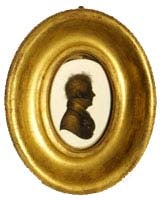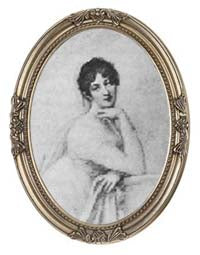James Stanier Clarke: Librarian to the Prince of Wales
"I am quite honoured by your thinking me capable of drawing such a clergyman as you gave the sketch of... But I assure you I am not. The comic part of the character I might be equal to, but not the good, the enthusiastic, the literary. Such a man's conversation must be on subjects of science and philosophy, of which I know nothing; or must occasionally be abundant in allusions and quotations which a woman who, like me, knows only her mother tongue, and has read very little in that, would be totally without the power of giving. A classical education, or at any rate a very extensive acquaintance with English literature, ancient and modern, appears to me quite indispensable for the person who would do justice to your clergyman; and I think I may boast myself to be, with all possible vanity, the most unlearned and ill-informed female who ever dared to be an authoress."
-Jane Austen to James Stanier Clarke, December 11th 1815
James Stanier Clarke, chaplain and librarian to the Prince of Wales, is a figure with connections to Austen that has remained relatively unexplored. Born in Minorca in 1765, James Stanier Clarke completed his early education in southern England and matriculated from St John's College, Cambridge in 1784. Clarke took holy orders in 1790 and by 1795, had entered the Royal Navy as a chaplain. As naval chaplain aboard H.M.S. Impetueux, Clarke was introduced by John Willet Payne to George, the Prince of Wales. Towards the end of his service, George appointed Clarke as his domestic chaplain and librarian, thus commencing his association with the Royal family.
Shortly after his appointment as Royal Chaplain in 1799, Clarke founded The Naval Chronicle with John MacArthur, secretary to Admiral Lord Hood. It had been less than a year since Nelson’s defeat of the French fleet at the Battle of the Nile and with the fate of England still in the hands of the Royal Navy, public interest was at an all time high. Both Clarke and MacArthur were well situated to develop their contacts. The magazine, which featured up to date information about the navy and articles on maritime history, was a major success. Their publisher, Bunney and Gold, specialised in nautical books and began what would become a monthly publication for the next twenty years.
-
Alongside his duties as librarian and chaplain, Clarke found time to write and in 1803, he published The Progress of Maritime Discovery. This was followed by The Life of Admiral Lord Nelson, published in 1809 and coauthored with MacArthur. In 1815, Jane Austen was staying with her brother Henry Austen in London, caring for the publication details of her fourth book, Emma. At one point during her visit, Henry Austen became gravely ill. He was treated by a society doctor who also waited on the Royal Family. At some point, the doctor discovered that the sister waiting on his patient was none other than the anonymous author behind one of the Prince of Wales' favourite novels, Pride and Prejudice. After carrying the news to the Royal Family at Carlton House, Jane received the now famous invitation from the Prince’s secretary to tour the house and libraries. Assured by Clarke that she would receive every possible attention, Jane visited Carlton House on November 13, 1815.
No known record of this visit has survived, but the tour was the start of a correspondence between Clarke and Austen. An acknowledged friendship existed between the two, though Clarke seems to have underestimated Jane- he wrote that she 'Knows only her mother tongue' and 'Has read very little'. For her part, Jane reportedly 'found Mr Clarke not only a very courteous gentleman but also a very warm admirer of her talents'.* How welcome that warm admiration may have been, has been proven debatable. Austen was known to be a supporter of the Prince’s estranged wife, Caroline of Brunswick, declaring in 1813, 'I shall support her as long as I can, because she is a woman & because I hate her husband'. When her visit to Carlton was followed by a suggestion that she dedicate her upcoming work to the Prince, she was no doubt somewhat dismayed. Such a mark of royal favour was not to be dismissed, but the honour of dedicating her novel to a man she appears not to have admired much, must have seemed trying.
The ensuing correspondence between Clarke and Austen shows Austen’s desire to clarify the requirements of this favour. Clarke lost no time in offering his assurances that the Prince was honoured at the possibility of having the work dedicated to him, but also in proffering his own suggestions for her work. To an author who strove to maintain her privacy, such intrusions into her work must have been frustrating. Nevertheless, Austen bore it with typical good humour, retreating into her former style of self deprecating parody, both in her replies to his suggestions and when incorporating these suggestions into her humorous Plan of a Novel. Austen’s difficulty with the dedication and the details of arranging a specially bound edition of the novel to be presented to His Highness brought her in ever increasing contact with her publisher, John Murray, who gave her ample advice, lent her several books and contributed greatly to her 'Convenience and Amusement'.

James Stanier Clarke’s last letter from Austen is dated 1816 and in 1834, he died aged 68. Such might be the only known details of his life, were it not for rare book lover Richard Wheeler. In 1955, Wheeler found a slim volume in an antique store. Stamped on the spine were the initials J.S.C and the words 'Sacred To Friendship'. Upon opening the cover, Wheeler found over one hundred verses, drawings, watercolours and autographs from such noted celebrities as William Cowper, novelists Charlotte Smith and Anna Seward and painter George Romney. While many of the drawings are copies of famous works of art, there were among them watercolours of two unnamed women. Wheeler enlisted the Tate Gallery for help in identifying the two women.
The first was easily recognisable as Princess Caroline of Brunswick. As Clarke was a known intimate of the family, it is not surprising that this portrait should survive among his work. What it does prove is that he was a master miniaturist, creating images that are clear representations, over one hundred years after being painted. The second portrait is what may be the most exciting discovery of the book. Wheeler is now convinced that the image, portraying a woman in white muslin and dated 1815, is unquestionably Jane Austen. The portrait is not verified by the National Portrait Gallery, which claims ownership of the only authenticated likeness of Jane Austen, painted by her sister Cassandra. Wheeler has had his picture studied by physiognomists, who identify the sitter in Cassandra’s sketch as the same person appearing in Clarke's watercolour.

He has also scoured Jane Austen’s letters seeking to verify the clothing worn in the portrait. Visible beneath the subjects shawl is a long-sleeved white gown with black trim. On March 9, 1814, Jane Austen wrote from London to Cassandra: 'I wear my gauze gown today, long sleeves & all … & [have] plaited black satin ribbon around the top.' Certainly the gown is dressy, but wouldn’t someone honoured with a private tour of the Prince’s residence wear her very finest gown? Is it possible that we do indeed have a record of Jane Austen’s Carlton House visit? We may never know, but the clues are tantalising.
Enjoyed this article? If you don't want to miss a beat when it comes to Jane Austen, make sure you are signed up to the Jane Austen newsletter for exclusive updates and discounts from our Online Gift Shop.



Leave a comment
This site is protected by hCaptcha and the hCaptcha Privacy Policy and Terms of Service apply.